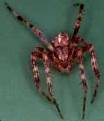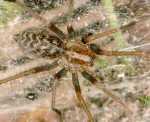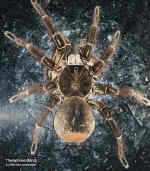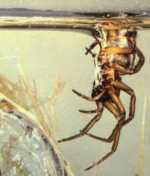Spider
Silk and Venom
Introduction

 Spiders
are arthropods of the class arachnida along with ticks, mites and scorpions.
Of the arachnids, they are in the order Araneae which contains about
40,000 known species found worldwide except in Antarctica.
In the UK, there are more than 630 species including the garden spider,
Araneus diadematus, which is reknowned for spinning beautiful webs.
There are three housespider species: Tegenaria domestica, Tegenaria
atrica and Tegenaria parietina (the cardinal spider).
Spiders
are arthropods of the class arachnida along with ticks, mites and scorpions.
Of the arachnids, they are in the order Araneae which contains about
40,000 known species found worldwide except in Antarctica.
In the UK, there are more than 630 species including the garden spider,
Araneus diadematus, which is reknowned for spinning beautiful webs.
There are three housespider species: Tegenaria domestica, Tegenaria
atrica and Tegenaria parietina (the cardinal spider).
 Spiders
have 8 legs, 8 simple eyes (4 pairs) and fangs with which they bite their prey. Most are less than 1 cm in length but the largest spider is the
bird-eating spider from South America with a body length of 9
cm. Males are often much smaller
than the females of the same species.
Spiders
have 8 legs, 8 simple eyes (4 pairs) and fangs with which they bite their prey. Most are less than 1 cm in length but the largest spider is the
bird-eating spider from South America with a body length of 9
cm. Males are often much smaller
than the females of the same species.
The general lifespan is about 1 year but males often die after mating and
females after egg-laying. The eggs are encased in a silken sac woven by
the female and after hatching, the young spiders molt until they reach adult
size.
 Spiders
are generally not social and are mostly terrestrial although some species
are aquatic, such as Argyroneta aquatica. Aquatic spiders breathe
underwater by trapping air bubbles with silk and dragging the bubbles with them.
Spiders
are generally not social and are mostly terrestrial although some species
are aquatic, such as Argyroneta aquatica. Aquatic spiders breathe
underwater by trapping air bubbles with silk and dragging the bubbles with them.
Spiders
are predators and they play an important role in agricultural and domestic pest
control since their main source of food is insects. Interest in how
spiders can help humans has become increasingly important, especially the
potential applications of natural or synthetic spider silk in the materials
industry and spider venom in medicine.

 Spiders
are arthropods of the class arachnida along with ticks, mites and scorpions.
Of the arachnids, they are in the order Araneae which contains about
40,000 known species found worldwide except in Antarctica.
In the UK, there are more than 630 species including the garden spider,
Araneus diadematus, which is reknowned for spinning beautiful webs.
There are three housespider species: Tegenaria domestica, Tegenaria
atrica and Tegenaria parietina (the cardinal spider).
Spiders
are arthropods of the class arachnida along with ticks, mites and scorpions.
Of the arachnids, they are in the order Araneae which contains about
40,000 known species found worldwide except in Antarctica.
In the UK, there are more than 630 species including the garden spider,
Araneus diadematus, which is reknowned for spinning beautiful webs.
There are three housespider species: Tegenaria domestica, Tegenaria
atrica and Tegenaria parietina (the cardinal spider). Spiders
have 8 legs, 8 simple eyes (4 pairs) and fangs with which they bite their prey. Most are less than 1 cm in length but the largest spider is the
bird-eating spider from South America with a body length of 9
cm.
Spiders
have 8 legs, 8 simple eyes (4 pairs) and fangs with which they bite their prey. Most are less than 1 cm in length but the largest spider is the
bird-eating spider from South America with a body length of 9
cm.  Spiders
are generally not social and are mostly terrestrial although some species
are aquatic, such as Argyroneta aquatica. Aquatic spiders breathe
underwater by trapping air bubbles with silk and dragging the bubbles with them.
Spiders
are generally not social and are mostly terrestrial although some species
are aquatic, such as Argyroneta aquatica. Aquatic spiders breathe
underwater by trapping air bubbles with silk and dragging the bubbles with them.